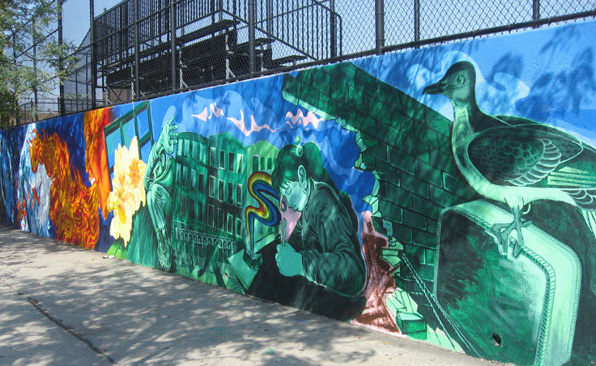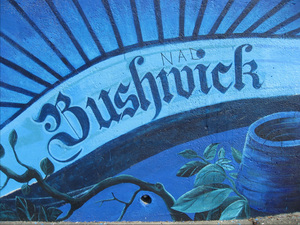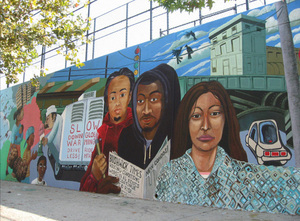This is an archive of the ArtCat Zine, 2007-2009. Please visit our new project, IDIOM.
Imagining Public History: "Time Flies" in Bushwick
Created by artists and students from the Academy of Urban Planning, El Puente Academy, and Groundswell Community Mural Project, the mammoth project was under the direction of muralist Joe Matunis and continues a tradition that has long been a Bushwick tradition — community murals.
In 1992, an earlier mural stood at this otherwise quiet corner and symptomatic of the time, it confronted issues of drugs, crime and social justice--which grappled this community.
Fast forward to 2007 and Bushwick has changed from the front lines of the city's drug wars to the next up-and-coming neighborhood. While the new wave of highly-educated hipsters homestead in this north Brooklyn neighborhood, "Time Flies" is one of the first public efforts by the predominantly black and Hispanic citizens of Bushwick to articulate their own thoughts about the neighborhood's future.
If the 1992 mural looked directly at hip-hop culture for its stylistic sources, "Time Flies" presents a more unified artistic sensibility and concise narrative (probably the gift of having the very talented Matunis at the helm). The painting seems to draw its cues from the origin of the muralist movement itself, namely the Mexican muralists of the early 20th century.
Eager to forge a visual history of their country and identity, Mexican artists like Diego Rivera and David Alfaro Siqueiros, were given the task of making a rich artistic representation of a nation still searching for its modern face. "Time Flies" attempts an equally important soul-searching. Read from right to left, the mural starts at the time Bushwick high school was built in 1904 and soars past its tragic past (like the 1977 riots during which time the neighborhood was devastated by arson and looting) to a present filled with gentrification and a future of promise. The three-part mural is divided evenly between past, present and future.
At the corner juncture smack dab in the middle of the mural, the most dramatic aspect of the painting acts as a dowel, connecting the two halves. The central figure, according to a recent article in the Williamsburg Courier, is a mythic African Sankofa bird. Flying forward while looking back, in African lore the Sankofa represents the hope to learn from the past while heading to the future. The bird also mimics the logo of the popular Firefox internet browser logo, perhaps a wink at youth culture — but then again Firefox was first called Phoenix before it was forced to change its name for copyright reasons.

The second half of the mural bursts into a symphony of carnivalesque images. Garish masks make way for a hipster bird or Hipstar as the artists cleverly rename the harbingers of gentrification. Hipsters are depicted as vultures with tattoos and sunglasses. I suppose that some people could view hipsters as feeding off the carcass of a once devastated and affordable Bushwick, forced out of the Lower East Side and Williamsburg, hipsters are now invading and graffiting Bushwick with their stickers and publications. But the other noticeable reality is that hipsters represent the beginning of the future.
One dark skinned young woman who holds up a flyer that asks, "What became of the passenger pigeon?" is represented with a vibrantly checkered shirt. It is one of the most beautiful parts of the mural as it hums and vibrates with an intense and palpable excitement.
The future is colored by environmentalism. A hand, fused of many parts, reaches across the wall into a future filled with growing forms, Central American native forms, the Arabic words for love and peace, a piece of origami and giant tropical flowers burst forth for the crescendo.
It is an epic history dominated by birds, which serve as metaphors for individual freedom. Stilted at first, they morph and transform first into fiery and then sinuous forms, unhindered by gravity and convention.
A decade ago, the murals of Bushwick were dominated by memorial of lives cut short. Today, those depressing memorials have slowly given way to the sense of communal memory moving towards visualizing a collective history rather than a personal tragedy.Like all history, there is editing involved and it is interesting to note the omissions in "Time Flies." The Italian community that dominated Bushwick from the 1950s until the 1970s is nowhere to be seen and the exclusion of non-black or Hispanics in the future section of the mural is also notable, as is the lack of LGBT identities — but those aren't the communities the mural seeks to influence. I also can't help but wonder what help it is to the community to portray hipsters as lowly bottom-feeders, further antagonizing a relationship between two communities (hipsters and non-hipsters) that is already fraught with misunderstanding and suspicion.
Nevertheless, the success of "Time Flies" lies in its strong graphic direction, coupled with a story that is told with a poetry that emerges from the tale and not one imposed from the outside. It is hard not to be moved by the vast panorama, but if you have the pleasure to see it then let its passion overwhelm you.
No longer is Bushwick a scene of blight and urban despair, "Time Flies" suggests it is a garden that continues to grow.
ZINE
HOME
TIPS / COMMENTS
CATEGORIES
CONTRIBUTORS
- Greg Afinogenov
- B. Blagojevic
- Adda Birnir
- Susannah Edelbaum
- Julie Fishkin
- Paddy Johnson
- Jessica Loudis
- Christopher Reiger
- Andrew Robinson
- Peter J. Russo
- Blythe Sheldon
- S.C.Squibb
- Hrag Vartanian


